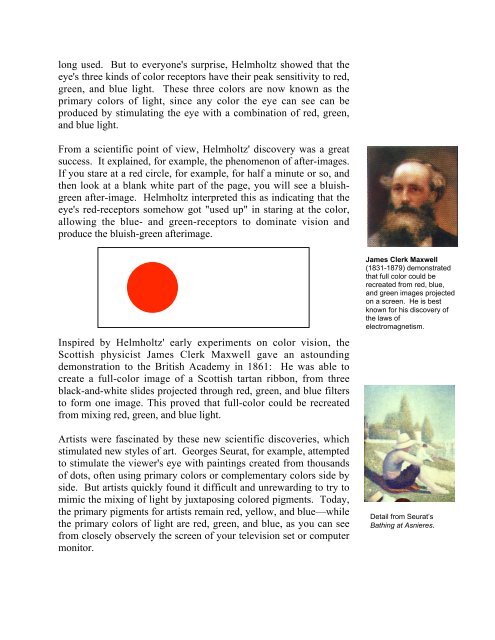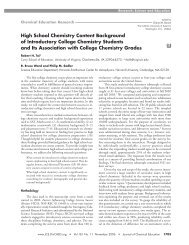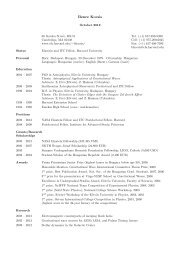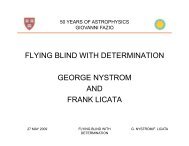What does the universe look like in color?
What does the universe look like in color?
What does the universe look like in color?
Create successful ePaper yourself
Turn your PDF publications into a flip-book with our unique Google optimized e-Paper software.
long used. But to everyone's surprise, Helmholtz showed that <strong>the</strong><br />
eye's three k<strong>in</strong>ds of <strong>color</strong> receptors have <strong>the</strong>ir peak sensitivity to red,<br />
green, and blue light. These three <strong>color</strong>s are now known as <strong>the</strong><br />
primary <strong>color</strong>s of light, s<strong>in</strong>ce any <strong>color</strong> <strong>the</strong> eye can see can be<br />
produced by stimulat<strong>in</strong>g <strong>the</strong> eye with a comb<strong>in</strong>ation of red, green,<br />
and blue light.<br />
From a scientific po<strong>in</strong>t of view, Helmholtz' discovery was a great<br />
success. It expla<strong>in</strong>ed, for example, <strong>the</strong> phenomenon of after-images.<br />
If you stare at a red circle, for example, for half a m<strong>in</strong>ute or so, and<br />
<strong>the</strong>n <strong>look</strong> at a blank white part of <strong>the</strong> page, you will see a bluishgreen<br />
after-image. Helmholtz <strong>in</strong>terpreted this as <strong>in</strong>dicat<strong>in</strong>g that <strong>the</strong><br />
eye's red-receptors somehow got "used up" <strong>in</strong> star<strong>in</strong>g at <strong>the</strong> <strong>color</strong>,<br />
allow<strong>in</strong>g <strong>the</strong> blue- and green-receptors to dom<strong>in</strong>ate vision and<br />
produce <strong>the</strong> bluish-green afterimage.<br />
Inspired by Helmholtz' early experiments on <strong>color</strong> vision, <strong>the</strong><br />
Scottish physicist James Clerk Maxwell gave an astound<strong>in</strong>g<br />
demonstration to <strong>the</strong> British Academy <strong>in</strong> 1861: He was able to<br />
create a full-<strong>color</strong> image of a Scottish tartan ribbon, from three<br />
black-and-white slides projected through red, green, and blue filters<br />
to form one image. This proved that full-<strong>color</strong> could be recreated<br />
from mix<strong>in</strong>g red, green, and blue light.<br />
Artists were fasc<strong>in</strong>ated by <strong>the</strong>se new scientific discoveries, which<br />
stimulated new styles of art. Georges Seurat, for example, attempted<br />
to stimulate <strong>the</strong> viewer's eye with pa<strong>in</strong>t<strong>in</strong>gs created from thousands<br />
of dots, often us<strong>in</strong>g primary <strong>color</strong>s or complementary <strong>color</strong>s side by<br />
side. But artists quickly found it difficult and unreward<strong>in</strong>g to try to<br />
mimic <strong>the</strong> mix<strong>in</strong>g of light by juxtapos<strong>in</strong>g <strong>color</strong>ed pigments. Today,<br />
<strong>the</strong> primary pigments for artists rema<strong>in</strong> red, yellow, and blue—while<br />
<strong>the</strong> primary <strong>color</strong>s of light are red, green, and blue, as you can see<br />
from closely observely <strong>the</strong> screen of your television set or computer<br />
monitor.<br />
James Clerk Maxwell<br />
(1831-1879) demonstrated<br />
that full <strong>color</strong> could be<br />
recreated from red, blue,<br />
and green images projected<br />
on a screen. He is best<br />
known for his discovery of<br />
<strong>the</strong> laws of<br />
electromagnetism.<br />
Detail from Seurat’s<br />
Bath<strong>in</strong>g at Asnieres.
















